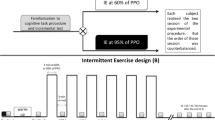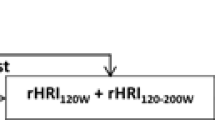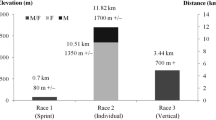Abstract
The aim of the present study was to investigate the relationship between physical fitness, heart rate variability (HRV) and cognitive function in 37 male sailors from the Royal Norwegian Navy. All subjects participated in an 8-week training program, after which the subjects completed the initial cognitive testing (pre-test). The subjects were assigned into a detrained group (DG) and a trained group (TG) based on their application for further duty. The DG withdrew from the training program for 4 weeks after which all subjects then completed the cognitive testing again (post-test). Physical fitness, measured as maximum oxygen consumption (V̇O2max), resting HRV, and cognitive function, measured using a continuous performance task (CPT) and a working memory test (WMT), were recorded during the pre-test and the post-test, and the data presented as the means and standard deviations. The results showed no between-group differences in V̇O2max or HRV at the pre-test. The DG showed a significant decrease in V̇O2max from the pre- to the post-test and a lower resting HRV than the TG on the post-test. Whereas there were no between-group differences on the CPT or WMT at the pre-test, the TG had faster reaction times and more true positive responses on tests of executive function at the post-test compared to the pre-test. The DG showed faster reaction times on non-executive tasks at the post-test compared to the pre-test. The results are discussed within a neurovisceral integration framework linking parasympathetic outflow to the heart to prefrontal neural functions.


Similar content being viewed by others
References
Ahern GL, Sollers JJ, Lane RD, Labiner MD, Herring AM, Weinand ME, Hutzler R, Thayer J (2001) Heart rate and heart rate variability changes in the intracarotid sodium amobarbital test. Epilepsia 42:912–921
Akselrod S, Gordon D, Ubel FA, Shannon DC, Barger AC, Cohen RJ (1981) Power spectrum analysis of heart rate fluctuation: a quantitative probe of beat-to-beat cardiovascular control. Science 213:220–222
Arnsten AFT (1998) Catecholamine modulation of prefrontal cortical cognitive function. Trends Cognit Sci 2:436–447
Baddeley AD, Hitch G (1974) Working memory. In: Bower GA (ed) The psychology of learning and motivation, vol 8. Academic, New York, pp 47–89
Benarroch EE (1993) The central autonomic network: functional organization, dysfunction, and perspective. Mayo Clin Proc 68:988–1001
Broadbent DE (1971) Decision and stress. Academic, London
Bronis M (1983) Heart rate variability and autonomic system: some possible relations. Automedia 4:223–225
Colcombe SJ, Kramer AF (2003) Fitness effects on the cognitive function of older adults: a meta-analytic study. Psychol Sci 14:125–130
Colcombe SJ, Kramer AF, Scalf P, McAuley E, Cohen NJ, Webb A, Jerome GJ, Marquez DX, Elavsky S (2004) Cardiovascular fitness, cortical plasticity, and aging. Proc Natl Acad Sci USA 101:3316–3321
Compte A, Brunel N, Goldman-Rakic PS, Wang XJ (2002) Synaptic mechanisms and network dynamics underlying spatial working memory in a cortical network model. Cereb Cortex 10:910–923
Cotman CW, Berchtold NC (2002) Exercise: a behavioral intervention to enhance brain health. Trends Neurosci 25:295–301
Etnier JL, Salazar W, Landers DM, Petruzzello SJ, Han M, Nowell P (1997) The influence of physical fitness and exercise upon cognitive functioning: a meta-analysis. J Sport Exerc Psychol 19:249–277
Friedman BH, Allen MT, Christe IC, Santucci AK (2002) Validity concerns of common heart-rate variability indices: addressing quantification issues in time- and frequency-domain measures of HRV. IEEE Eng Med Biol Mag 21:35–40
Fuster JM (2000) Prefrontal neurons in networks of executive memory. Brain Res Bull 52:331–336
Garavan H, Ross TJ, Stein EA (1999) Right hemispheric dominance of inhibitory control: an event-related functional MRI study. Proc Natl Acad Sci USA 96:8301–8306
Garavan H, Ross TJ, Li SJ, Stein EA (2000) A parametric manipulation of central executive functioning. Cereb Cortex 10:585–592
Garavan H, Ross TJ, Murphy K, Roche RAP, Stein EA (2002) Dissociable executive functions in the dynamic control of behavior: inhibition, error detection, and correction. NeuroImage 17:1820–1829
Giada F, Bertaglia E, De Piccoli B, Franceschi M, Sartori F, Raviele A, Pascotto P (1998) Cardiovascular adaptations to endurance training and detraining in young and older athletes. Int J Cardiol 65:149–155
Gianaros PJ, van der Veen FM, Jennings R (2004) Regional cerebral blood flow correlates with heart period and high-frequency heart period variability during working memory tasks: implications for the cortical and subcortical regulation of cardiac autonomic activity. Psychophysiology 41:1–9
Goldberg LR (1999) A broad-bandwidth, public domain, personality inventory measuring the lower-level facets of several five factor models. In: Mervielde I, Deary I, De Fruyt F, Ostendorf F (eds) Personality psychology in Europe. Tilburg University Press, Tilburg, pp 7–28
Goldman-Rakic PS (1997) Neurobiology. Space and time in the mental universe. Nature 386:559–560
Hansen AL, Johnsen BH, Thayer JF (2003) Vagal influence on working memory and sustained attention. Int J Psychophysiol 48:263–274
Hugdahl K, Thomsen T, Landrø NI, Ersland L, Smievoll AI, Lundervold A, Barndon R, Sundberg H, Iversen JK, Roscher B (2000) Separating mental arithmetic from working memory: an fMRI study. NeuroImage 11:384
Imai K, Sato H, Hori M, Kusuoka H, Ozaki H, Yokoyama H, Takeda H, Imoue M, Kamada T (1994) Vagally-mediated heart rate recovery after exercise is accelerated in athletes but blunted in patients with chronic heart failure. J Am Coll Cardiol 24:1529–1535
Katona PG, McLean M, Dighton D, Guz A (1982) Sympathetic and parasympathetic cardiac control in athletes and nonathletes at rest. J Appl Physiol 52:1652–1657
Klaver CHAM, de Geus EJC, de Vries J (1994) Ambulatory monitoring system. In: Maarse FJ (ed) Computers in psychology 5. Applications, methods and instrumentation. Swets and Zeitlinger, Lisse
Kramer AF, Hahn S, Cohen NJ, Banich MT, McAuley E, Harrison CR, Chason J, Vakil E, Bardell L, Boileau RA, Colcombe A (1999) Ageing, fitness and neurocognitive function. Nature 400:418–419
Kramer AF, Hahn S, McAuley E (2000) Influence of aerobic fitness on the neurocognitive function of older adults. J Aging Physical Act 8:379–385
Lane RD, Reiman EM, Ahern GL, Thayer JF (2001) Activity in the medial prefrontal cortex correlates with the vagal component of heart rate variability during emotion. Brain Cogn 47:97–100
LeMura LM, von Duvillard SP, Andreacci J, Klebez JM, Chelland SA, Russo J (2000) Lipid and liporotein profiles, cardiovascular fitness, body composition, and diet during and after resistance, aerobic and combination exercise in young men. Eur J Appl Physiol 82:451–458
Levy MN (1990) Autonomic interactions in cardiac control. Ann N Y Acad Sci 601:209–221
Malenka RC, Nicoll RA (1999) Long-term potentiation: a decade of progress? Science 285:1870–1874
Masterman DL, Cummings JL (1997) Frontal-subcortical circuits: the anatomical basis of executive, social and motivated behaviors. J Psychopharmacol 11:107–114
Mayberg HS, Liotti M, Brannan SK, McGinnis S, Mahurin RK, Jerabek PA, Silva JA, Tekell JL, Martin CC, Lancaster JL, Fox PT (1999) Reciprocal limbic-cortical function and negative mood: converging PET findings in depression and normal sadness. Am J Psychiatry 156:675–682
Miles R (2000) Diversity in inhibition. Science 287:244–246
Miller EN (1999) CalCAP. California computerized assessment package manual, 2nd edn. Norland Software, Los Angeles
Porges SW (1992) Autonomic regulation and attention. In: Campbell BA, Hayne H, Richardson R (eds) Attention and information processing in infants and adults. Erlbaum, Hillside pp 201–223
Rossy LA, Thayer JF (1998) Fitness and gender-related differences in heart period variability. Psychosom Med 60:773–781
Salgado JF (1998) Big Five personality dimensions and job performance in army and civil occupations: a European perspective. Hum Perform 11:271–288
Saul JP (1990) Beat-to-beat variations of heart rate reflect modulation of cardiac autonomic outflow. News Physiol Sci 5:32–37
Schneider W (1988) Micro experimental laboratory: an integrated system for IBM PC compatibles. Behav Res Methods Comput 20:643–661
Socan G, Bucik V (1998) Relationship between speed of information-processing and two major personality dimensions—extraversion and neuroticism. Pers Indiv Diff 25:35–48
Spyer KM (1989) Neural mechanisms involved in cardiovascular control during affective behavior. Trends Neurosci 12:506–513
Ter Horst GJ, Postema F (1997) Forebrain parasympathetic control of heart activity: retrograde transneuronal viral labeling in rats. Am J Physiol 273:2926–2930
Thayer JF, Lane RD (2000) A model of neurovisceral integration in emotion regulation and dysregulation. J Affect Disord 61:201–216
Tomporowski PD, Ellis NR (1986) Effects of exercise on cognitive process: a review. Psychol Bull 99:338–346
Acknowledgements
The present study was supported by grants from the Norwegian Ministry of Defense and the Meltzer Foundation, University of Bergen.
Author information
Authors and Affiliations
Corresponding author
Rights and permissions
About this article
Cite this article
Hansen, A.L., Johnsen, B.H., Sollers, J.J. et al. Heart rate variability and its relation to prefrontal cognitive function: the effects of training and detraining. Eur J Appl Physiol 93, 263–272 (2004). https://doi.org/10.1007/s00421-004-1208-0
Accepted:
Published:
Issue Date:
DOI: https://doi.org/10.1007/s00421-004-1208-0




